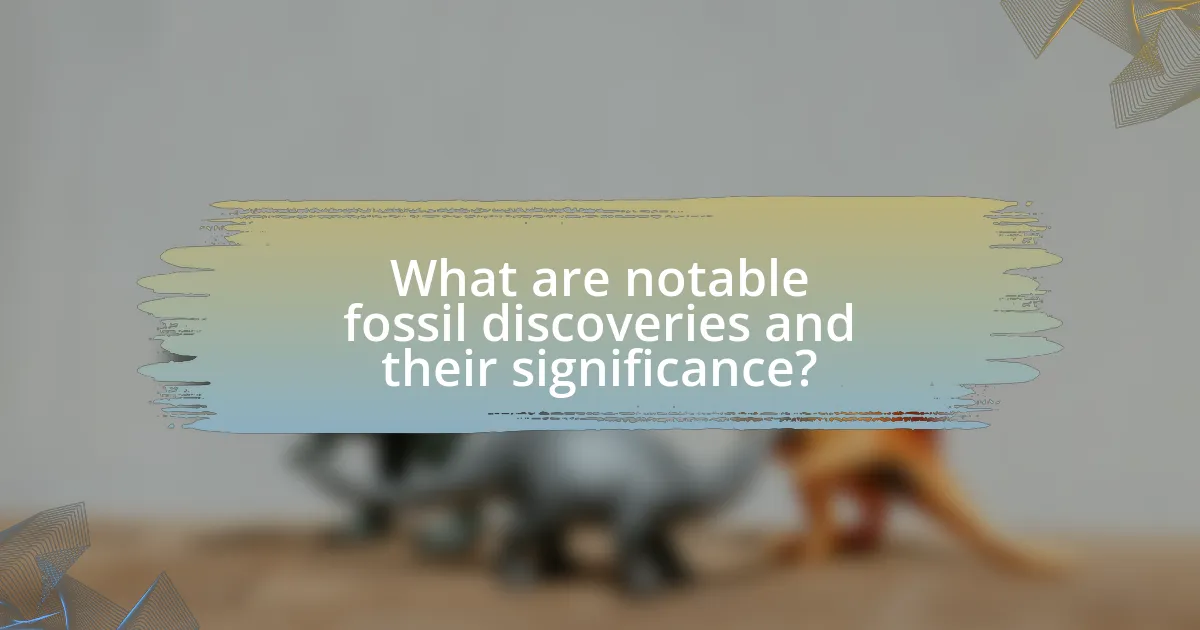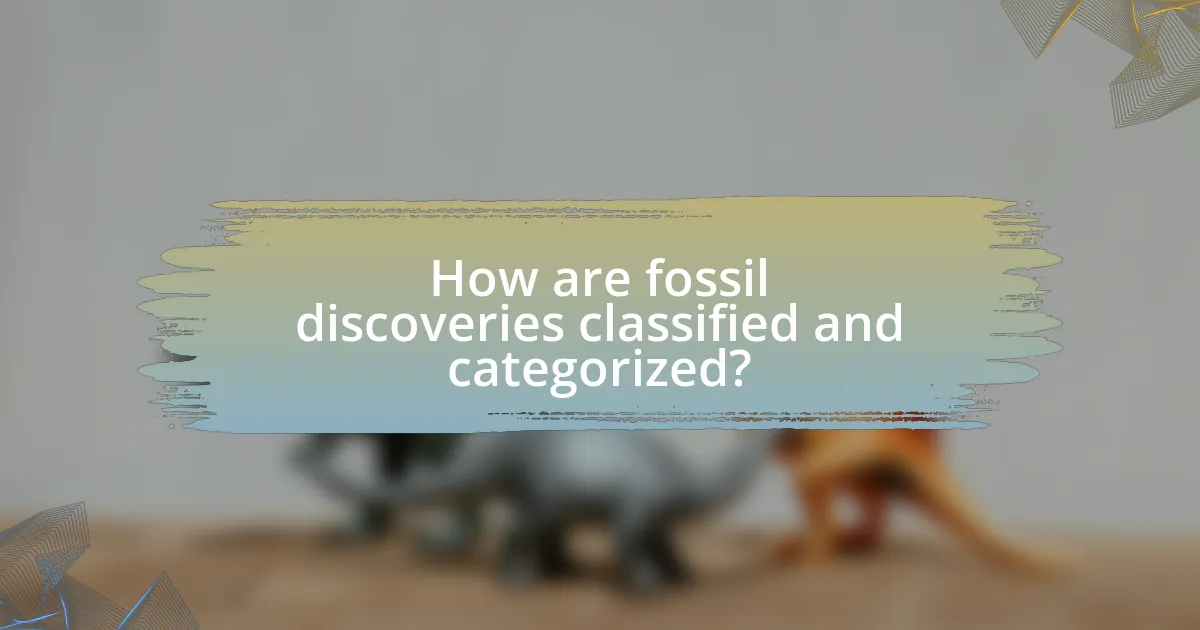The article focuses on notable fossil discoveries and their significance in understanding prehistoric life and evolutionary processes. Key discoveries such as Archaeopteryx, Tyrannosaurus rex, and fossils from the La Brea Tar Pits are highlighted for their contributions to paleontology and evolutionary biology. The article discusses methods for identifying and dating fossils, the impact of technology on fossil studies, and the challenges faced in classifying fossil discoveries. Additionally, it examines the implications of these findings on evolutionary theories and the importance of context and rarity in determining the significance of fossil finds.

What are notable fossil discoveries and their significance?
Notable fossil discoveries include the Archaeopteryx, which is significant as it provides evidence of the evolutionary link between dinosaurs and birds. Discovered in Germany in 1861, Archaeopteryx exhibits both avian and reptilian features, supporting the theory of evolution by demonstrating transitional forms. Another important discovery is the fossilized remains of the Tyrannosaurus rex, found in North America, which has contributed to our understanding of dinosaur behavior, physiology, and extinction events. The La Brea Tar Pits in California have yielded numerous well-preserved fossils, offering insights into the Pleistocene epoch’s ecosystem and the species that inhabited it. Each of these discoveries has advanced paleontological knowledge and shaped our understanding of life’s history on Earth.
How do fossil discoveries contribute to our understanding of prehistoric life?
Fossil discoveries significantly enhance our understanding of prehistoric life by providing direct evidence of ancient organisms and their environments. These fossils reveal information about the morphology, behavior, and evolution of species that existed millions of years ago. For instance, the discovery of the Archaeopteryx fossil in the 19th century demonstrated the link between dinosaurs and modern birds, showcasing transitional features such as feathers and a wishbone. Additionally, fossils like those of the woolly mammoth have offered insights into the climate and ecosystems of the Pleistocene epoch, illustrating how species adapted to their surroundings. Such findings are crucial for reconstructing the history of life on Earth and understanding evolutionary processes.
What methods are used to identify and date fossil discoveries?
Fossil discoveries are identified and dated primarily through methods such as stratigraphy, radiometric dating, and paleomagnetic dating. Stratigraphy involves analyzing the layers of rock in which fossils are found, allowing scientists to determine the relative age based on the sequence of sedimentary layers. Radiometric dating, particularly using isotopes like carbon-14 for more recent fossils or uranium-lead for older specimens, provides absolute ages by measuring the decay of radioactive elements. Paleomagnetic dating examines the magnetic properties of rocks to correlate fossil ages with known shifts in Earth’s magnetic field. These methods are validated by their consistent application in various geological contexts, demonstrating their reliability in accurately identifying and dating fossil discoveries.
How do fossil discoveries influence evolutionary theories?
Fossil discoveries significantly influence evolutionary theories by providing tangible evidence of past life forms and their morphological changes over time. These fossils serve as critical data points that help scientists trace the lineage of species, illustrating how organisms have evolved through natural selection and environmental adaptations. For instance, the discovery of transitional fossils, such as Archaeopteryx, which exhibits both avian and reptilian features, supports the theory of evolution by demonstrating the gradual transition from dinosaurs to birds. Additionally, the fossil record reveals patterns of extinction and diversification, further informing our understanding of evolutionary processes. Such findings validate and refine existing evolutionary models, making fossil discoveries essential to the ongoing development of evolutionary biology.
What are some landmark fossil discoveries in history?
Some landmark fossil discoveries in history include the Archaeopteryx, the first known bird from the Late Jurassic period, which provided crucial evidence for the evolution of birds from dinosaurs. Another significant discovery is the fossilized remains of the Tyrannosaurus rex, which have offered insights into the anatomy and behavior of large theropods. The La Brea Tar Pits in California have yielded a wealth of Ice Age fossils, including saber-toothed cats and mammoths, illustrating the diversity of prehistoric life. Additionally, the discovery of the Australopithecus afarensis, particularly the famous “Lucy” specimen, has been pivotal in understanding human evolution. Each of these discoveries has contributed essential knowledge to the fields of paleontology and evolutionary biology.
Which fossil discoveries have changed our understanding of specific species?
Fossil discoveries such as the Archaeopteryx and the Tiktaalik have significantly altered our understanding of specific species. Archaeopteryx, discovered in Germany in the 19th century, provided crucial evidence for the evolutionary link between dinosaurs and birds, showcasing features like feathers and a wishbone that were previously thought to be exclusive to birds. Tiktaalik, unearthed in Canada in 2004, revealed transitional characteristics between fish and tetrapods, demonstrating how vertebrates adapted to life on land approximately 375 million years ago. These discoveries have reshaped the narrative of evolutionary biology by providing concrete examples of transitional forms.
What role did technology play in these landmark discoveries?
Technology played a crucial role in landmark fossil discoveries by enabling advanced methods of analysis and visualization. For instance, techniques such as radiographic imaging and 3D scanning have allowed paleontologists to examine fossils in detail without damaging them, revealing internal structures and facilitating accurate reconstructions. Additionally, molecular analysis technologies, including DNA sequencing, have provided insights into the evolutionary relationships of species, enhancing our understanding of biodiversity and extinction events. These technological advancements have significantly improved the accuracy and efficiency of fossil identification and classification, as evidenced by the successful identification of previously unknown species through these methods.

How are fossil discoveries classified and categorized?
Fossil discoveries are classified and categorized based on several criteria, including their type, age, and the geological context in which they are found. Paleontologists primarily categorize fossils into body fossils, which are the remains of the organism itself, and trace fossils, which record the activity of organisms, such as footprints or burrows. Additionally, fossils are dated using methods like radiometric dating, which provides information about their age, allowing for further classification into specific geological time periods. The context of the fossil’s discovery, including the rock layer and location, also plays a crucial role in categorization, as it helps scientists understand the environmental conditions of the time. This systematic approach to classification is essential for reconstructing the history of life on Earth and understanding evolutionary processes.
What are the different types of fossils and their identification methods?
The different types of fossils include body fossils, trace fossils, and chemical fossils. Body fossils are the preserved remains of organisms, such as bones, teeth, and shells, while trace fossils record the activity of organisms, such as footprints or burrows. Chemical fossils, also known as biomarkers, are organic compounds that provide evidence of past life.
Identification methods for fossils involve morphological analysis, stratigraphic context, and radiometric dating. Morphological analysis examines the physical characteristics of fossils to classify them, while stratigraphic context assesses the layers of rock in which fossils are found to determine their relative ages. Radiometric dating uses the decay of radioactive isotopes to establish the absolute age of fossils, providing a timeline for when the organisms existed. These methods are validated by extensive research in paleontology, including studies published in journals such as “Paleobiology” and “Geological Society of America Bulletin.”
How do paleontologists differentiate between various fossil types?
Paleontologists differentiate between various fossil types primarily through morphological analysis, which involves examining the physical characteristics of fossils. This analysis includes assessing features such as size, shape, and structure, which can indicate the organism’s classification. For example, the distinct skeletal structures of dinosaurs versus mammals allow paleontologists to categorize them accurately. Additionally, paleontologists utilize stratigraphy, the study of rock layers, to determine the relative age of fossils, which helps in understanding the evolutionary timeline. Fossils found in specific geological formations can also provide context about the environment in which the organism lived, further aiding in classification.
What are the challenges in classifying fossil discoveries?
Classifying fossil discoveries presents several challenges, primarily due to the incomplete nature of the fossil record. Fossils are often fragmented, making it difficult to determine their exact species or evolutionary relationships. Additionally, the morphological variations within species can lead to misclassification, as similar features may arise independently in different lineages, a phenomenon known as convergent evolution. Furthermore, the lack of contextual information, such as the geological setting or associated flora and fauna, complicates the classification process. These challenges are underscored by the fact that approximately 99% of all species that have ever existed are believed to be extinct, leaving paleontologists with limited data for accurate classification.
What criteria are used to determine the significance of a fossil find?
The significance of a fossil find is determined by several criteria, including its age, preservation quality, uniqueness, and the information it provides about evolutionary history. Age is critical as older fossils can offer insights into earlier life forms and environmental conditions. Preservation quality affects the fossil’s ability to provide accurate data; well-preserved specimens yield more reliable information. Uniqueness refers to whether the fossil represents a new species or a rare find, which can enhance its scientific value. Additionally, the fossil’s contribution to understanding evolutionary processes or ecological changes further establishes its significance. For instance, the discovery of the Archaeopteryx fossil in the 19th century was significant due to its age and its role in illustrating the link between dinosaurs and birds, thus providing crucial evidence for evolutionary theory.
How does the context of a fossil discovery affect its importance?
The context of a fossil discovery significantly affects its importance by providing critical information about the environment, age, and evolutionary relationships of the organism. For instance, fossils found in sedimentary layers can indicate the geological period and the ecological conditions at the time of the organism’s existence. The discovery of the Archaeopteryx fossil in Germany, which dates back to the Late Jurassic period, is crucial because it illustrates the transition between dinosaurs and birds, highlighting evolutionary processes. Additionally, the location of a fossil can reveal patterns of migration, adaptation, and extinction, making the context essential for understanding biodiversity and the history of life on Earth.
What role does rarity play in the significance of fossil discoveries?
Rarity significantly enhances the importance of fossil discoveries by indicating unique evolutionary events or environmental conditions. When fossils are rare, they often represent species that were uncommon or existed for a limited time, providing critical insights into biodiversity and extinction events. For instance, the discovery of the rare dinosaur species, Therizinosaurus, has offered valuable information about the diversity of theropods during the Late Cretaceous period, highlighting evolutionary adaptations. Such rare finds can also help paleontologists understand past ecosystems and climate changes, as they often reflect specific conditions that allowed for the preservation of these organisms.

What are some case studies of notable fossil discoveries?
Some notable fossil discoveries include the fossilized remains of the Tyrannosaurus rex, discovered in Montana in 1990, which provided significant insights into the anatomy and behavior of this dinosaur. Another case study is the discovery of the Archaeopteryx in Germany in 1861, which is considered a crucial link between dinosaurs and birds, showcasing features of both groups. Additionally, the La Brea Tar Pits in Los Angeles have yielded a wealth of fossils from the Pleistocene epoch, including saber-toothed cats and mammoths, offering a glimpse into the ecosystem of that time. Each of these discoveries has contributed to our understanding of evolutionary biology and paleontology.
How did the discovery of the Archaeopteryx impact our understanding of bird evolution?
The discovery of Archaeopteryx significantly advanced our understanding of bird evolution by providing a clear link between dinosaurs and modern birds. This fossil, first identified in 1861, exhibited both avian and reptilian features, such as feathers and a wishbone, alongside characteristics like teeth and a long bony tail. These traits demonstrated that birds evolved from theropod dinosaurs, supporting the theory of evolution and the concept of transitional forms in the fossil record. Archaeopteryx became a pivotal example in paleontology, illustrating the gradual transition from non-avian dinosaurs to birds, thereby reshaping scientific perspectives on the evolutionary lineage of birds.
What evidence supports the classification of Archaeopteryx as a transitional fossil?
Archaeopteryx is classified as a transitional fossil due to its combination of avian and reptilian features. This species exhibits feathers similar to modern birds, indicating its capability for flight, while also possessing characteristics such as teeth, a long bony tail, and clawed fingers, which are typical of theropod dinosaurs. The discovery of Archaeopteryx in the late 19th century, particularly the well-preserved specimens from the Solnhofen limestone in Germany, provided critical evidence of its mixed traits. These fossils demonstrate the evolutionary link between birds and reptiles, supporting the theory of evolution by showcasing a clear morphological transition.
What controversies arose from the Archaeopteryx discovery?
The discovery of Archaeopteryx sparked controversies primarily regarding its classification as a transitional fossil between dinosaurs and birds. Some paleontologists debated whether Archaeopteryx should be classified as a bird due to its avian features, such as feathers and a wishbone, while others argued it retained many dinosaur-like characteristics, including a long bony tail and teeth. This debate highlighted differing interpretations of evolutionary evidence and the criteria for defining a species as a bird versus a dinosaur. The significance of Archaeopteryx in understanding avian evolution remains contested, with some researchers asserting it is a key link, while others suggest it may not represent a direct ancestor of modern birds.
What insights were gained from the discovery of the Tyrannosaurus rex?
The discovery of the Tyrannosaurus rex provided significant insights into the behavior, physiology, and ecology of large theropod dinosaurs. This species, identified in the early 20th century, revealed that T. rex was a top predator, showcasing adaptations such as powerful jaws and keen senses, which indicated its role in the ecosystem as a scavenger and hunter. Fossil evidence, including well-preserved bones and teeth, demonstrated its size, estimated at up to 40 feet long and weighing around 9 tons, which helped paleontologists understand the scale of predation during the Late Cretaceous period. Additionally, studies of T. rex fossils have suggested that it may have exhibited social behavior, as some findings indicate potential evidence of pack hunting or social interactions among individuals. These insights have been crucial in reconstructing the life and environment of one of the most iconic dinosaurs in history.
How has the T. rex discovery influenced popular culture and science?
The discovery of T. rex has significantly influenced both popular culture and science by establishing the dinosaur as a symbol of prehistoric life and a subject of intense scientific study. In popular culture, T. rex has become an iconic figure, prominently featured in films like “Jurassic Park,” which has shaped public perception of dinosaurs and sparked widespread interest in paleontology. This cultural representation has led to increased attendance at museums and educational programs focused on dinosaurs.
In the scientific realm, the T. rex discovery has advanced our understanding of dinosaur biology, behavior, and evolution. Research on T. rex has provided insights into theropod anatomy and the evolutionary link between dinosaurs and modern birds. Notably, the discovery of soft tissue and proteins in T. rex fossils has opened new avenues for studying ancient DNA and protein structures, as highlighted in the work of paleontologist Mary Schweitzer. This combination of cultural impact and scientific advancement underscores the T. rex’s role as a pivotal figure in both fields.
What advancements in technology were utilized in studying T. rex fossils?
Advancements in technology utilized in studying T. rex fossils include computed tomography (CT) scanning, which allows researchers to visualize the internal structures of fossils without damaging them. This non-invasive imaging technique has enabled scientists to analyze the bone density and morphology of T. rex specimens in detail. Additionally, techniques such as laser scanning and 3D printing have facilitated the creation of accurate models for further study and public display. These technologies have significantly enhanced the understanding of T. rex anatomy and its evolutionary context, as evidenced by studies published in journals like “Nature” and “PLOS ONE,” which highlight the impact of these methods on paleontological research.
What lessons can be learned from the study of notable fossil discoveries?
The study of notable fossil discoveries teaches us about the evolutionary history of life on Earth, revealing how species have adapted over time. For instance, the discovery of the Archaeopteryx fossil demonstrates the transition from dinosaurs to birds, providing evidence of evolutionary processes such as natural selection. Additionally, fossils like those of the woolly mammoth offer insights into past climates and ecosystems, helping scientists understand how species respond to environmental changes. These findings underscore the importance of paleontology in informing current biodiversity conservation efforts and predicting future ecological shifts.
How can future fossil discoveries be better preserved and studied?
Future fossil discoveries can be better preserved and studied through the implementation of advanced imaging technologies and controlled environmental conditions. Utilizing techniques such as 3D scanning and digital modeling allows for detailed documentation without physical contact, minimizing damage. Additionally, maintaining fossils in stable temperature and humidity environments prevents degradation, as evidenced by the successful preservation of specimens in controlled settings like the Natural History Museum in London. These methods enhance both the preservation and accessibility of fossils for ongoing research and education.
What best practices should researchers follow when identifying fossils?
Researchers should follow systematic excavation, detailed documentation, and comparative analysis when identifying fossils. Systematic excavation involves carefully removing sediment layers to avoid damaging fossils, ensuring that the context of the find is preserved. Detailed documentation includes recording the location, stratigraphy, and associated materials, which aids in understanding the fossil’s geological context. Comparative analysis requires researchers to compare the fossil with known specimens in databases or collections, facilitating accurate identification. These practices are supported by the guidelines established by the Society of Vertebrate Paleontology, which emphasize the importance of context and thorough documentation in paleontological research.





